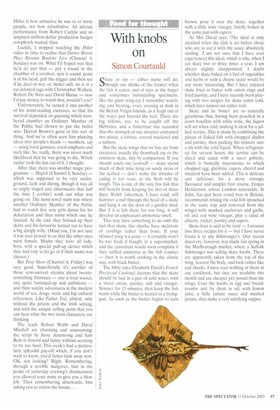With knobs on
Simon Courtauld
Skate or ray — either name will do, though one thinks of the former when the fish is eaten, and of rays as the larger and sometimes intimidating specimens, like the giant sting-ray I remember watching, and hearing, every evening at dusk in the British Virgin Islands, as it leapt out of the water just beyond the reef. There are big fellows, too, to be caught off the Hebrides, and a fisherman has recorded that the stomach of one monster contained two plaice, a lobster, several mackerel and a salmon,
But the skate wings that we buy are from creatures, usually the thornback ray or the common skate, tiny by comparison. If you should catch one yourself — skate spend much of their time lying on sandy areas of the seabed — don't make the mistake of eating it too soon, as the flesh will be tough. This is one of the very few fish that will benefit from keeping for two or three days; Welsh fishermen, I have read, will hammer a nail through the head of a skate and hang it on the door of a garden shed. But if it is left there for too long, it will develop an unpleasant ammoniac smell.
This may have something to do with the fact that skate, like sharks, have skeletons of cartilage rather than bone. If your skinned wing is a point — it certainly won't be too fresh if bought in a supermarket, and the customers would soon complain if they sniffed ammonia at the fish counter — then it is worth cooking in the classic way, with black butter.
The bible (aka Elizabeth David's French Provincial Cooking) decrees that the skate should be laid in a pan of cold water, with a sliced onion, parsley, salt and vinegar. Simmer for 15 minutes, then keep the fish warm while the butter is heated in a fryingpan. As soon as the butter begins to turn brown, pour it over the skate, together with a little wine vinegar, briefly boiled in the same pan with capers.
As Mrs David says, The ideal is only attained when the dish is set before those who are to eat it with the sauce absolutely sizzling.' I am not sure that I have ever experienced this ideal, which is why, when I eat skate two or three times a year, I am always slightly disappointed. I doubt whether skate baked on a bed of vegetables and herbs or with a cheese sauce would be any more interesting. But I have enjoyed skate fried in batter with onion rings and fried parsley; and I have recently been playing with two recipes for skate eaten cold, which have turned out rather well.
Skate and its 'bones' are so naturally gelatinous that, having been poached in a court bouillon with white wine, the liquor will set when cold, making it ideal for a jellied terrine. This is made by combining the pieces of flaked fish with chopped shallot and parsley, then packing the mixture into a tin with the cold liquid. When refrigerated for several hours, the terrine can be sliced and eaten with a sauce gfibiche, which is basically mayonnaise to which chopped egg, gherkins, capers, chervil and mustard have been added. This is delicate and delicious; for a more strongly flavoured and simpler first course, Fergus Henderson. whose London restaurant, St John, has just been voted best in Britain, recommends mixing the cold fish (poached in the same way and removed from the wings) with mashed anchovies and garlic, oil and red wine vinegar, plus a salad of chicory, rocket, parsley and capers.
Skate liver is said to be tasty — Larousse lists three recipes for it — but I have never found it in any fishmonger's. One recent discovery, however, was made last spring in the Marlborough market, where a Suffolk fishmonger was selling skate knobs. These are apparently taken from the top of the wing, nearest the body, and look rather like cod cheeks, I have read nothing of them in any cookbook, but they are available this month and are cheaper per pound than the wings. Coat the knobs in egg and breadcrumbs and fry them in oil; with lemon juice, a little tartare sauce and mashed potato, they make a very satisfying supper.


















































































 Previous page
Previous page